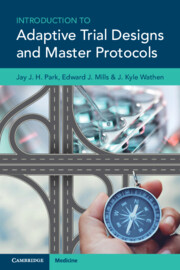Book contents
- Introduction to Adaptive Trial Designs and Master Protocols
- Introduction to Adaptive Trial Designs and Master Protocols
- Copyright page
- Content
- Preface
- About the Authors
- Part I Introduction and History of Clinical Trial Research
- Part II Basic Ingredients for Adaptive Trial Designs and Common Types
- Part III Basic Ingredients for Master Protocols
- Chapter 6 Characteristics and Principles of Master Protocols
- Chapter 7 Platform Trials
- Chapter 8 Basket Trials and Umbrella Trials
- Part IV Case Studies of Adaptive Trial Designs and Master Protocols
- Part V A Practical Guide to Adaptive Trial Designs and Master Protocols
- Index
- References
Chapter 7 - Platform Trials
from Part III - Basic Ingredients for Master Protocols
Published online by Cambridge University Press: 20 March 2023
- Introduction to Adaptive Trial Designs and Master Protocols
- Introduction to Adaptive Trial Designs and Master Protocols
- Copyright page
- Content
- Preface
- About the Authors
- Part I Introduction and History of Clinical Trial Research
- Part II Basic Ingredients for Adaptive Trial Designs and Common Types
- Part III Basic Ingredients for Master Protocols
- Chapter 6 Characteristics and Principles of Master Protocols
- Chapter 7 Platform Trials
- Chapter 8 Basket Trials and Umbrella Trials
- Part IV Case Studies of Adaptive Trial Designs and Master Protocols
- Part V A Practical Guide to Adaptive Trial Designs and Master Protocols
- Index
- References
Summary
In this chapter, we review the concept of platform trials in close detail. Platform trials refer to clinical trials that allow new interventions to be added to the platform over time even, if they are not pre-specified in the design stage. Platform trials can be applied to all phases of clinical trial research. While they are most often conducted as randomised clinical trials with adaptive trial designs (adaptive platform randomised trials), they can be conducted with non-randomised or fixed sample trial designs as well. As a general goal, platform trials aim to establish a shared trial infrastructure where multiple interventions can be evaluated. Independent clinical trial evaluation would result in multiple separate teams creating shorter term infrastructure and trials that would otherwise compete against each other. Platform trials represent an exciting turning point for clinical research. The key design considerations of platform trials are outlined in this chapter.
- Type
- Chapter
- Information
- Publisher: Cambridge University PressPrint publication year: 2023



